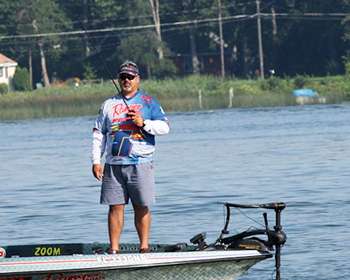
Florida's Peter Thliveros is known as one of the best Carolina riggers on the Elite Series tournament trail. The veteran pro is renowned for his ability to slowly seine a piece of structure, using a heavy weight and a plastic lure at the end of a relatively short leader to milk offshore areas for all they are worth. But when Thliveros locates bass on cover he can't see, sometimes they're not susceptible to the Carolina rig.
In many of those cases, a more aggressive presentation shuts down the bite completely. That's when he often turns to the split shot technique, a scaled down Carolina rig with some distinct advantages over its big brother. "Usually I use it in clear water situations where the fish are turned off by an aggressive presentation and where stealth or finesse is required," he says.
Unlike the thunderous splash of a Carolina rig weight, the split shot enters the water cleanly and comparatively silently. During the retrieve, the differences are substantial as well — while the big Carolina weight dredges up dirt and rock along the bottom, the split shot is much less intrusive.
"On a Carolina rig, the clunky weight is part of the attraction," Thliveros explains. "But in clear water, the bass can be spooked by the noise. The split shot is more natural, with a free-floating natural movement of the bait, and the fish don't shy away from it."
In Peter T's case, the term "split shotting" is something of a misnomer. While in the past he may have used a small crimp-on lead sinker, now he uses a Tru-Tungsten bullet weight and a matching Smart Peg to hold it in place. The weight is more compact and transmits more feel up the line than a lead sinker of comparable heft. "I'll go as light as 1/32 ounce or as heavy as 3/16, depending on water depth and wind conditions," he says. Normally he pegs the sinker 8 to 10 inches ahead of his lure.
While hand-poured worms and featureless centipedes may be popular lures for this technique, Thliveros says most of the time he uses a Zoom Super Fluke. On rare occasions when the situation calls for this presentation but fish have grown tired or wary of the Super Fluke, he'll thread on a crawfish, a finesse worm or a soft plastic stickbait. While his hookup rate has always been good, he says that it's gotten even better since he started using a 3/0 Mihatchii worm hook.
"For years I used an offset shank round bend worm hook," he explains. "But this hook has a keeper and the eye of the hook is in line with the eye. It's kind of a round bend but a little more closed and that keeps the fish hooked." His retrieve is simple, with the goal of allowing the bait to rise briefly and then fall back toward the bottom in a natural fashion.
"You gently raise your rod tip," he says. "But you don't want to impart any action." He keeps a fair amount of slack in the line, often fishing it with a bow in between movements. Accordingly, the majority of the time he won't feel the bite until the fish starts swimming away with his Fluke.
While many anglers use spinning tackle for this sort of tactic, Thliveros still chooses to use his baitcasting gear. His weapons of choice include a 7-foot, 2-inch American Rodsmiths Mag Strike Carolina Rig rod, paired with a 6.3:1 gear ratio reel spooled with 10- to 15-pound-test fluorocarbon. His line choice depends on the type of cover he's fishing. While many anglers may think of this sort of presentation as a "limit getter," aimed at catching lots of small fish rather than a few big ones, he says that's a mistake. He's used it at Amistad when most of his competition was throwing big jigs and swimbaits. Same with Champlain, where jigs, crankbaits and spinnerbaits are the norm. Perhaps most tellingly, he used it almost exclusively at the 2007 Bassmaster Major at New York's Oneida Lake. While the 11 other anglers in the final round plied the water with more aggressive tactics, it was Thliveros and his stealth rig that earned the trophy and the six-figure paycheck.





